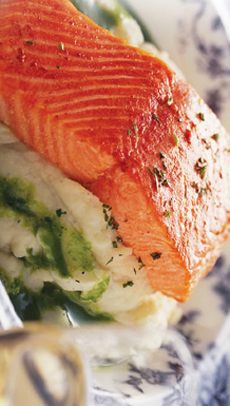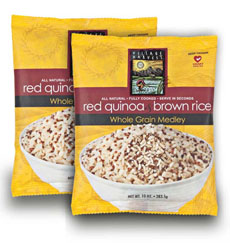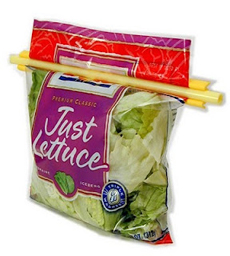
Coconut oil makes a delicious glaze for
salmon. Photo courtesy Vital Choice. |
|
Baking Trays: This trick is simple and subtle, but can yield exceptional results. Try greasing your baking trays with coconut oil. From muffin tins to cake pans, anything you plan on baking at 350°F can benefit from a a little tropical goodness. You may not notice it in bigger and bolder desserts, but when its subtle presence does register, you’ll have a new, delicious layer of flavor in your baked treats.
Caramelized Onions: Simply caramelize onions as you normally would, but use coconut oil in place of butter or other oil. Just remember to adjust your heat accordingly, in order to keep the coconut oil from smoking.
Chicken (with skin on): Whenever you cook skin-on chicken pieces, you should be starting them out by seasoning them well and searing them in a very hot pan. If you don’t, you’re missing out on the amazingness that is crispy chicken skin. It’s a little indulgent, sure; but eaten in moderation you have little to worry about. The next time you want to get your skin crispy, do it in coconut oil. You may never go back to your previous oil.
|
|
Glaze/Sauce For Fish: In a small saucepan over medium heat, whisk together 2 tablespoons of coconut oil, 1 tablespoon of butter, a teaspoon of rice vinegar, a tablespoon of sambal chili paste, the zest of an orange, the juice of half an orange and a tablespoon of black sesame seeds. Try it on salmon; you’ll be very happy you did.
Grilled Corn: Save this tip for local summer corn. Slather the ear of corn in coconut oil, wrap it in foil and throw it on the grill. For added flavor intensity, remove the foil for the last few minutes. Summer corn just got even sweeter!
Hearty Grains: From amaranth to barley to farro and even polenta (see our Grains Glossary for more ideas), cook the grains as you normally would. Then fold in coconut oil a tablespoon at a time, until you reach your desired flavor profile. A few drops of acid (citrus, vinegar or other favorite) for pop and the right amount of seasoning will make any grain prepared like this taste truly exceptional.
Pad Thai: A couple tablespoons of peanut butter, a squeeze of lime juice, a teaspoon of sugar, a teaspoon of fish sauce and a tablespoon of coconut oil create a quick and and easy Pad Thai sauce. This is not a traditional recipe by any means, but it is on par and definitely delicious. Make the dish with your choice of noodles (I’m partial to wide rice noodles), protein (shrimp and egg for me, but chicken, pork and tofu will work), and garnish (mung bean sprouts, crushed peanuts, sliced green onions, more lime juice and a generous spoonful of sambal). There’s no need to go out for pad thai when it’s so easy to make at home.
Popcorn: Use coconut oil to pop your corn, using the old-fashioned, sans-microwave method. Simply drop a tablespoon or two of coconut oil into the pot before the corn kernels, and you’ll end up with popcorn scented gently with that incredible coconut aroma. A little bit of salt and butter, and you’re good to go.
Seared Mushrooms: If you can get your hands on some big King Trumpet mushrooms, they’re ideal for this application, cut into just 2 or 3 thick slices lengthwise to preserve the integrity of their shape. If not, standard white/button mushrooms are fine; slice them as you would the King Trumpets, into thick slices. Get the coconut oil to just before smoking point and drop in the mushrooms, taking care to get each piece against the pan and everything in a single layer. Then simply keep an eye on them and be patient. After 5 to 8 minutes, flip one piece over. If you see a luscious golden-brown coloring on one side, give the pan a shake to flip the rest. The coconut flavor gets infused into the meat of the mushroom and the resulting sweet umami treat is unique and incredible. Make sure to season with salt and pepper, but not until after you flip the mushrooms.
Spinach & Other Greens You need nothing more than the greens, the coconut oil, salt and pepper. Sauté the greens until wilted and season to taste: Getting kids and resistant adults to eat their vegetables may become a whole lot easier. (One note: This doesn’t work well with collard greens. Collards are the one kind of hearty green that need more than a sauté to cook down to an edible pleasantness. You either have to braise them for a while, or at least blanch them prior to sautéing. Other greens like chard, kale and spinach wilt/break down more easily, and can therefore be easily sautéed).
If you can’t find Dr. Bronner’s virgin coconut oils locally (try natural food and health food stores), both white kernel and whole kernel oils are available on Amazon.
|











